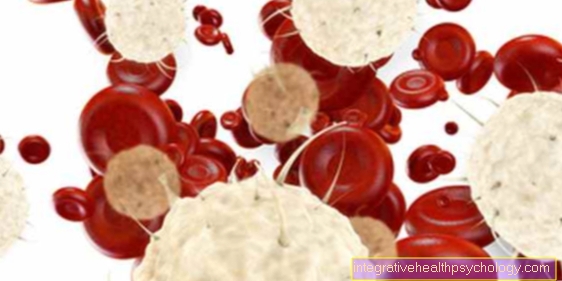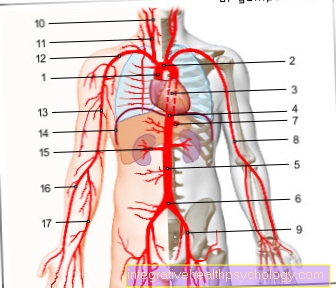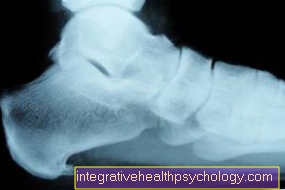Liver values
What are the liver values and what do they mean?
The term "Liver values“Is a synonym for the measurable concentration of certain enzymes in the patient's blood serum, which primarily originate from the cells of the liver and are therefore regarded as liver-specific parameters or markers and can be determined in the diagnosis of liver and biliary tract diseases.
The liver values are among the parameters most frequently determined by the doctor in the patient's blood serum. As a rule, the concentration of four enzymes is determined as part of the blood sample:
- the gamma-glutamyl transferase (short: Gamma-GT / gGT),
- glutamate pyruvate transaminase (in short: GPT, also called alanine aminotransferase - in short: ALT or ALAT),
- glutamate oxaloacetate transaminase (in short: GOT, also called aspartate aminotransferase - in short: AST or ASAT) and
- alkaline phosphatase (in short: AP).
Read more on the topic: Functions of the liver

The GPT occurs mainly in the liver cells, the GOT, the gGT and the AP, however, can also be found in many other organ tissues and are therefore less liver-specific, which is why all four enzymes are usually determined at the same time. The AP is very specific for biliary tract diseases such as a bile congestion from gallstones.
The more liver values increase, the more specifically this indicates pathological processes in the liver. The most sensitive liver and biliary tract marker is gGT, while GOT and GPT often only increase when the liver cells are more severely damaged.
However, the liver values in the patient's blood may be elevated without significant symptoms or other indications of a liver or biliary tract disease. An increase in values does not have to be exclusively the result of a liver disease. Factors such as long-term medication, alcohol and / or drug consumption, stress or an incorrect, high-fat diet can lead to an increase in liver values.
The following normal values are considered valid for the four important liver values (U / l = units per liter):
- gGT <60 U / l (Men) or <40 U / l (Women)
- GPT <50 U / l (Men) or <35 U / l (Women)
- GOT <50 U / l (Men) or <35 U / l (Women)
- AP 40-130 U / l (Men) or 35-105 U / l (Women)
Overview of all liver values
- ALAT / GPT:
Man: Maximum 50 U / L, Minimum ---
Woman: maximum 35 U / L, minimum --- - ASAT / GOT:
Man: Maximum 50 U / L
Woman: maximum 35 U / L - GGT:
Man: Maximum 66 UIL
Woman: maximum 39 U / L - Choline esterase:
Man: Maximum 13,000 U / L, minimum 5,200 U / L
Woman: maximum 10,300 U / L, minimum 4,000 U / L - Alkaline phosphatase:
Man: maximum 129 U / L, minimum 40 U / L
Woman: maximum 104 U / L, minimum 35 U / L - Total bilirubin:
Male: Maximum 19 micromoles / L, minimum 2 micromoles / L
Woman: maximum 19 micromol / L, minimum 2 micromol / L - GLDH:
Man: maximum 7 U / L, minimum ---
Woman: maximum 5 U / L, minimum --- - Quick value:
Man: maximum 120%, minimum 70%
Woman: maximum 120%, minimum 70%
gGT
The so-called enzyme gamma-glutamyl transferase (for short: Gamma GT or GGT / gGT).
This enzyme is found in various tissues in the body, including in the cells of the liver, kidney, spleen, pancreas and small intestine.
It is used there primarily for metabolic processes (e.g. protein metabolism), but it is also involved in inflammatory processes and in the breakdown of pollutants (e.g. alcohol).
The enzyme is membrane-bound, i.e. it is present in the membrane of cells.
It is also involved in the transport of amino acids into the cells.
The breakdown of glutathione, an important molecule within the cells, is initiated by the gGT.
Although this enzyme occurs in many body tissues, the detection of an increased concentration of gGT in the blood serum when a blood sample is taken is a sign of pathological processes in the liver and / or the biliary tract, since the largest proportion of the enzyme to be determined in the blood serum comes from here (liver-specific) .
Since the enzyme is usually bound to the wall of the liver and biliary tract cells, they are released into the blood with the slightest damage to these cells.
So it is a very sensitive parameter.
The norm values for men are around 60 U / l, for women up to 40 U / l.
The value is always determined by the doctor if there is a suspicion of a liver or biliary tract disease or alcohol abuse.
In general, however, the gGT is not liver-specific, which means that diseases in other organs can also cause an increase; nevertheless, the level of the value correlates with the extent of damage (the higher the value, the more serious the damage).
Read more on the topic: Liver value GGT
GPT

The characteristic liver values include also the enzyme Glutamate pyruvate transaminase (in short: GPT), also under the name Alanine aminotransferase (in short: ALT or ALAT) is known. This enzyme is mainly found in the liver, but is also found in small amounts in the cells of the Skeletal and cardiac muscles to find.
Its task is primarily to participate in Protein metabolism the cells or the respective organ. If an increased amount of this enzyme is found in the patient's blood serum, this is usually a sign of illness or for pathological processes of the liver and / or biliary tract as these organs are the body's main source of this enzyme.
Since the enzyme is inside the (Liver / biliary tract) Cells are located, it is only released into the blood if they are damaged to the point that they perish. This is possible, for example, with a Inflammation of the liver (hepatitis), at a Fatty liver disease, at Alcohol or drug abuse or at one Biliary obstruction.
The normal values for men are up to 50 U / l, in women up to 35 U / l.
GOT
Like the enzyme GPT, the enzyme also counts Glutamate oxaloacetate transaminase (in short: GOT) or also Aspartate aminotransferase (in short: AST or ASAT), one of the characteristic liver values that can be determined in the blood count.
Like GPT, GOT occurs primarily in the cells of the liver, of the skeleton- and the Heart muscles before, but also in small proportions in the tissue of the pancreas, of the Kidneys, of Brain and the lung.
It is also primarily on Protein metabolism of the respective cells involved. If the value of the GOT in the blood increases, this is usually an indication of pathological processes in the liver or the biliary tract, but this enzyme is considered to be a little less specific than for example the GPT or the gGT.
So it can also be with severe muscle injuries or Muscle disordersin which muscle cells die down, the enzyme is released and the GOT level in the patient's blood serum rises.
This is why the GOT value is usually not determined on its own, but in combination with other values such as the GPT or the gGT.
The normal values for men are up to 50 U / l, in women up to 35 U / l.
Liver values in hepatitis
As a rule, if liver damage is suspected in the context of hepatitis, the liver values GOT, GPT and GGT are determined together with other values that are not related to the liver.
However, the change in liver values also depends on the type and severity of the hepatitis.
Depending on the type (hepatitis A-E), this can be strong or weak and show acute or chronic courses.
In acute, severe viral hepatitis, the liver values, like GGT, rise faster and more strongly than in chronic, less pronounced viral hepatitis.
You can find all information about the disease hepatitis in the following article: The hepatitis - everything you should know
Liver values in cirrhosis of the liver
In the case of liver cirrhosis, various values are determined to confirm the diagnosis and to monitor the progress.
In addition to the typical liver values GOT, GPT, GLDH, bilirubin and GGT, which are increased in liver cirrhosis, other parameters can also be determined.
Cholinesterase, various coagulation factors and other products of the liver belong to the certain values.
These are often not the typical liver values, as in many cases they are either not indicative or not specific for the liver.
They are also mostly decreased rather than increased, since the synthesis capacity of the liver decreases as the disease progresses.
How to treat cirrhosis of the liver, read below: This is how cirrhosis of the liver is treated
Liver values in fatty liver
The liver values in fatty liver depend on how the disease developed.
If the disease does not occur in the context of chronic alcohol abuse, the transaminases are also increased in addition to the typically increased gamma-GT.
The transaminases include GOT and GPT.
The De-Ritis quotient is the relationship between AST and ALT or GOT and GPT.
This is usually less than 1.
In the case of fatty liver that is the result of chronic alcohol abuse, the gamma-GT is typically also increased.
If a fatty liver with inflammation has already developed from a pure fatty liver, the GOT, GPT, GLDH and alkaline phosphatase are also increased.
In addition, the synthesis output can already be reduced, which can also be proven in the laboratory.
The de-ritis quotient is usually above 1.
By determining the value of the CDT, alcohol consumption can be estimated.
Liver values in liver cancer
In liver cancer, the typical liver values are also determined.
The transaminases GOT and GPT as well as the two values of gamma-GT and alkaline phosphatase are determined.
Usually only the transaminases are increased.
In addition, the liver synthesis performance is determined by determining other parameters such as the coagulation factors.
In later stages these can be lowered.
The tumor marker AFP is also an important marker for liver cancer.
In the event of multiple determinations, this can provide a good prognosis.
All further information about this malignant disease can be found at: Liver cancer - causes & forms
Can you determine liver values yourself?
The liver values can be determined by the person concerned.
For this purpose, special tests have been developed that are easy to use.
A blood sample is also required for this.
Like a laboratory, the test can determine all the necessary laboratory parameters.
The determination of the liver values is not quite as reliable compared to a laboratory.
There are also various portals on the Internet that help you assess your liver values.
For this, some data such as age and weight must be entered.
In addition, information about habits such as eating behavior is required.
However, this method does not provide absolute values, only a rough guide.
How often should you have your own liver values determined?
The frequency of determination of the liver values should vary depending on the risk profile.
A determination of the liver values does not make sense in healthy people.
Even if some risk factors for potential liver damage are shown, liver values will usually not be determined.
If desired, you can determine your liver values yourself using a home test.
Even if the liver values are elevated, a determination is usually only useful in acute illness.
In chronically ill patients, however, the liver values should be determined regularly in order to assess the course.
This should happen every six months or so.
If in doubt, however, it makes sense to seek the advice of a doctor.
Can you also examine liver values in urine?
Some liver values can also be determined by examining urine.
The so-called mid-stream urine is usually used for this.
The determination is usually made using test strips that are dipped into the urine.
However, the examination of the urine does not provide absolute values, but only approximate information.
The values tested include bilirubin or urobilinogen.
Changes in liver values during pregnancy
Changes in liver values during pregnancy are relatively rare.
However, it is important to recognize this, otherwise severe consequences threaten.
You should also be aware that some liver values always change during pregnancy.
This has no disease value and is the typical adaptation of the mother's body to pregnancy.
The typical liver values GOT, GPT and GGT should not show any changes.
The serum bilirubin and the existing INR for the coagulation assessment should also show no changes.
Urea and creatinine can be reduced without disease values.
Hemoglobin and albumin may also be lowered.
In contrast, there are some values that can be increased.
Alkaline phosphatase is included in this.
Some other values can also be increased.
However, these are not necessarily directly related to the liver.
These are cholesterol, triglycerides (both blood lipids), alpha-fetoprotein and fibrinogen.
A deviation in the values in the other direction or a change in other liver values represents a disease value.
What are the reasons for an increase?
Behind one Increase in liver values There can be many different causes in the blood serum, which primarily affect diseases of the liver and / or biliary tract, but can also be independent of these two organ systems.
The most common causes are acute or chronic hepatitis (Inflammation of the liver), one fatty liver disease caused by alcohol or non-alcohol (Fatty liver, fatty liver hepatitis), the Cirrhosis of the liver as the end stage of liver cell destruction, the permanent ingestion of Medication (e.g. pain relievers or antibiotics) that have to be metabolized and broken down by the liver Closure of the biliary tract by e.g. Gallstones or one Mushroom poisoning.
The less common causes of elevated liver values include Iron storage disease (Hemochromatosis), the chronic inflammation of the biliary tract (primary sclerosing cholangitis), of the Liver cancer or the Copper storage disease (Wilson disease).
Because the enzymes called liver values are also found in various other organs in the body, an increase in - especially the transaminases GOT and GPT - also expression of other diseases that have nothing to do with the liver or biliary tract.
Since the GOT e.g.Also occurs in larger quantities in the heart and skeletal muscles, damage there (e.g. heart attack, skeletal muscle diseases) can also lead to an increase in liver values or GOT.
Furthermore can also vigorous physical exercise, Infectious diseases (Syphilis, tuberculosis, worms), Hormonal disorders (Thyroid malfunction, diabetes), Cardiovascular diseases (Heart failure, pericardial effusion) and a permanently increased stress (increased cortisol release) may be the cause.
Alcohol as a cause?

Alcohol is considered to be one of the substances that has a toxic effect on the liver and, if consumed regularly or in excess, leads to permanent damage to the liver cells. The amount of alcohol that is harmful to humans varies from person to person, but the general limit value can roughly be said that 40g alcohol per day for men and 20g alcohol per day for women is the excess that the liver can bear.
Excessive or long-term consumption of alcohol beyond the acceptable limit value leads to the fact that the metabolic status of the liver cells changes over time and the cells are overwhelmed, so that toxic by-products are created when the constantly flowing alcohol is broken down (acetaldehyde). These by-products accumulate in the liver and lead to - first - fatty liver disease with possibly accompanying symptoms of inflammation of the liver (Fatty liver hepatitis), which with continued alcohol consumption can lead to liver cell destruction and fibrosis (Cirrhosis of the liver) can pass.
Chronic alcohol consumption can be noticed in the context of a blood sample through increased CDT and MCV values, if liver cell damage or even liver cell death occurs, the specific liver values such as gGT, GOT and GPT also increase. The level of the liver values can usually be correlated with the extent of the liver damage.
You can also read more information on the subject on our website: Consequences of alcohol.
Can stress increase liver values?
Stress has many effects on the body.
In addition to the consequences for the psyche, stress can also make itself felt in the organs of the body.
If stress is present over a longer period of time, it can also affect the functioning of the liver.
This is noticeable by increased liver values.
Typically, the transaminases GOT and GPT are elevated.
The synthesis performance of the liver is usually not affected.
Also, the increase in liver values is usually not perceived subjectively, but only noticed through the determination in the laboratory.
For more effects of stress on the body, see this article: Consequences of stress
Does vitamin D change liver values?
Vitamin D is converted into a hormone in the liver by various enzymes.
The transaminases GOT and GPT are involved in this.
There is an interdependence between vitamin D and the enzymes.
This means that if there is a lack of vitamin D, more enzymes are formed for the production and conversion of the vitamin into the hormone.
This increases the liver values of the GOT and GPT in the case of vitamin D deficiency.
In the case of a liver disease in which the function is restricted, there is in turn a deficiency in vitamin D.
Improve liver values
The increase is often due to a fatty liver caused by poor diet and alcohol abuse, so that a change to a low-fat diet and a reduction in alcohol consumption often lead to an improvement in liver values.
Read more on the topic: Diet for fatty liver
The regular intake of certain drugs, which are preferably metabolized and broken down by the liver, can lead to an increase in liver values in the long term. This includes, for example, many pain relievers and also some antibiotics. These may have to be discontinued after a medical consultation.
In addition, chronic stress can also lead to an increase in liver values: Under stress, the body increasingly produces the stress hormone cortisol, which in the long term can also lead to fatty liver, as it reduces the formation of fat-degrading enzymes in the liver cells. A reduction in stress in general can therefore also help to improve elevated liver values.
Further information on the topic can be found here: How can I best lower my liver values?
Depending on the cause, hepatitis is treated with antiviral, antibacterial or immunosuppressive methods.
You can find more information about this under our topic: Treatment of Hepatitis
Please also read our topic: increased liver values
MPU
The abbreviation MPU hides the so-called "medical psychological examination", which is used to assess the Fitness to drive or. Fitness to drive is carried out in traffic (popularly known as the "idiot test").
This test - which has been carried out in the Federal Republic of Germany since 1954 - is carried out in assessment centers for driving fitness for suspicious persons in order to reduce the risk of traffic accidents on the roads. Both the mental and psychological, as well as the physical fitness to drive, the duration of the examination is between 3 to 4 hours.
The medical part of the test is based on checking Drug or alcohol abuse based on medical Conversation, physical Investigations and one Blood collection with subsequent laboratory determination of certain relevant parameters such as liver values gGT, GOT, GPT and the alcohol parameters CDT (Carbohydrate Deficient Transferrin) and EtG (Ethyl glucuronide). To successfully complete the MPU, the liver (and especially the alcohol values) must not be elevated.
The medical-psychological examination serves as the decisive basis for the decision on the withdrawal or the re-granting of the driving license in traffic.





























